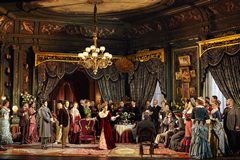| Opera Reviews | 18 April 2024 |
A solid, well executed La Traviataby Michael Sinclair |
|
| Verdi: La Traviata Opera Australia Sydney Opera House 25 February 2017 |
|
|
This Elijah Moshinsky production of La Traviata (revived here by Hugh Halliday) dates back to 1994 and offers traditional sensibilities in abundance. Michael Yeargan’s opulent period sets and Peter J. Hall’s elegant costumes are a feast for the eye, while Moshinsky’s direction takes a straightforward approach to the story avoiding controversy or criticism. If the approach says little new about the work, it is unabashedly solid, dependable and well executed. Without a concept to hang on to, the success of an endeavor like this largely falls on the singers to execute their roles with honesty, integrity and passion – and of course great singing. On the whole Opera Australia have assembled a largely home based cast for the twenty-two performances, who fulfill their duties on this particular evening with aplomb. Criticism of the overuse of overseas singers would be unfair here. Taking over from Ermonela Jaho who sang Violetta in the first six performances, Lorina Gore is herself an experienced interpreter of Dumas’ ‘fallen woman’ having sung the role previously in this production and also for New Zealand Opera. The role lies comfortably within her voice, with only the highest ranges of the coloratura passages in “Sempre libera” stretching her vocal resources. Otherwise she combines vocal richness with moving pianissimo singing, the latter particularly effective in the Act II encounter with Giorgio Germont. If there is a stark contrast between Gore’s frail acting demeanor and her robust singing in the final act, she nevertheless portrays the human will to survive with heartfelt and moving intensity. Ho-Yoon Chung has a pleasant tenor voice that generally meets the musical challenges of the role of Alfredo, though his approach is somewhat one dimensional with little subtlety either in terms of vocal or dramatic characterisation. He is at his most effective in Flora’s party scene where his angry outbursts are convincingly portrayed. As Giorgio Germont, José Carbó presents a stern father figure intent on retaining the family’s honour. His well projected muscular voice conveys dark admonishment in Act II, yet somehow lacks an underlying fatherly warmth to make his encounter with Violetta truly heartbreaking. All the smaller roles are well taken including Dominica Matthew’s flirtatious Flora, Adrian Tamburini’s statuesque Baron Douphol and Gennadi Dubinski’s sympatheitic Doctor Grenvil. In the pit Renato Palumbo leads the Opera Australia Orchestra in a refined, well-paced performance of the score stamping their authority on the performance while accompanying the singers with sensitivity. The Opera Australia Chorus’s contribution in the party scenes ensures that the energy levels remain high in these exuberant scenes. So, a solid performance – perhaps a little too solid – though the near capacity audience showed their approval confirming the enduring ability of Verdi’s opera to weave its magic web however traditional the production may be.
|
|
| Text © Michael Sinclair Photo © Keith Saunders |

 Opera Australia’s summer season in Sydney is generally devoted to extended runs of popular operas in traditional productions with a range of casts. This year the summer repertoire includes La bohème, Tosca and this production of La Traviata. The company comes in for much criticism for this approach, both for its unambitious programming and an increasing use of overseas artists. There is no simple answer here – the demand for such performances seems to remain high, boosted by the high season tourist influx. On the evening of this performance two Cunard cruise ships were in the harbour – Queen Mary 2 and Queen Elizabeth – with their passengers no doubt swelling the numbers in the theatre. While loyal local opera goers may lament this approach, this season at least they did have something to cheer about with Szymanowski’s King Roger, performances that proved to be both an artistic as well as a financial success. Perhaps a little bit more balance will keep everyone happy.
Opera Australia’s summer season in Sydney is generally devoted to extended runs of popular operas in traditional productions with a range of casts. This year the summer repertoire includes La bohème, Tosca and this production of La Traviata. The company comes in for much criticism for this approach, both for its unambitious programming and an increasing use of overseas artists. There is no simple answer here – the demand for such performances seems to remain high, boosted by the high season tourist influx. On the evening of this performance two Cunard cruise ships were in the harbour – Queen Mary 2 and Queen Elizabeth – with their passengers no doubt swelling the numbers in the theatre. While loyal local opera goers may lament this approach, this season at least they did have something to cheer about with Szymanowski’s King Roger, performances that proved to be both an artistic as well as a financial success. Perhaps a little bit more balance will keep everyone happy.





